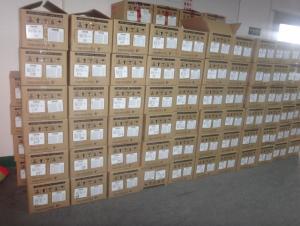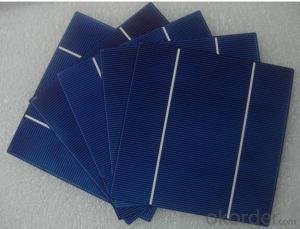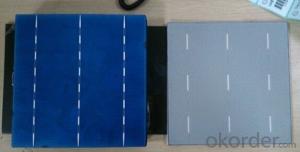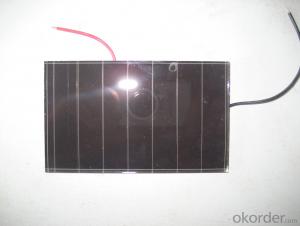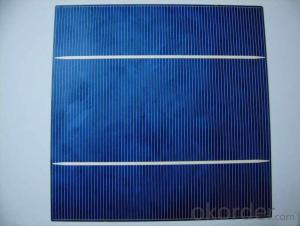Solar Cell High Quality A Grade Cell Monorystalline 5v 17.8%
- Loading Port:
- Shanghai
- Payment Terms:
- TT OR LC
- Min Order Qty:
- 1000 pc
- Supply Capability:
- 100000 pc/month
OKorder Service Pledge
OKorder Financial Service
You Might Also Like
Specifications
hot sale solar cell
1.16.8%~18.25% high efficiency
2.100% checked quality
3.ISO9001/ISO14001/TUV/CE/UL
4.stable performance
We can offer you the best quality products and services, don't miss !
POLY6'(156*156)
Polycrystalline Silicon Solar cell
Physical Characteristics
Dimension: 156mm×156mm±0.5mm
Diagonal: 220mm±0.5mm
Thickness(Si): 200±20 μm
Front(-) Back(+)
Blue anti-reflecting coating (silicon nitride); Aluminum back surface field;
1.5mm wide bus bars; 2.0mm wide soldering pads;
Distance between bus bars: 51mm . Distance between bus bars :51mm .
Electrical Characteristics
Efficiency(%) | 18.00 | 17.80 | 17.60 | 17.40 | 17.20 | 16.80 | 16.60 | 16.40 | 16.20 | 16.00 | 15.80 | 15.60 |
Pmpp(W) | 4.33 | 4.29 | 4.24 | 4.19 | 4.14 | 4.09 | 4.04 | 3.99 | 3.94 | 3.90 | 3.86 | 3.82 |
Umpp(V) | 0.530 | 0.527 | 0.524 | 0.521 | 0.518 | 0.516 | 0.514 | 0.511 | 0.509 | 0.506 | 0.503 | 0.501 |
Impp(A) | 8.159 | 8.126 | 8.081 | 8.035 | 7.990 | 7.938 | 7.876 | 7.813 | 7.754 | 7.698 | 7.642 | 7.586 |
Uoc(V) | 0.633 | 0.631 | 0.628 | 0.625 | 0.623 | 0.620 | 0.618 | 0.617 | 0.615 | 0.613 | 0.611 | 0.609 |
Isc(A) | 8.709 | 8.677 | 8.629 | 8.578 | 8.531 | 8.478 | 8.419 | 8.356 | 8.289 | 8.220 | 8.151 | 8.083 |
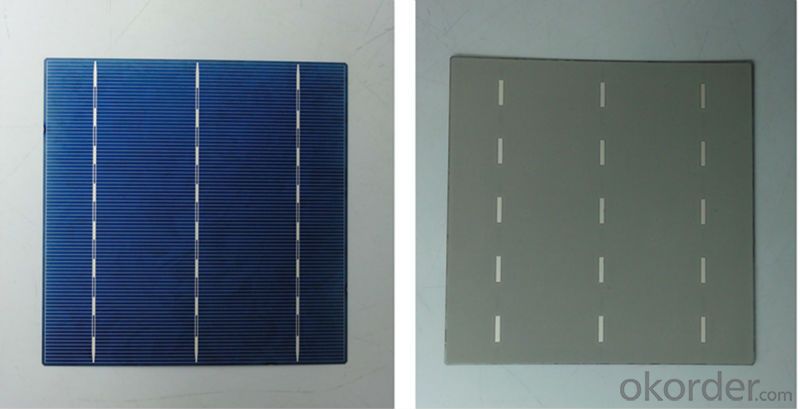
MONO5'(125*125mm)165
Monocrystalline silicon solar cell
Physical Characteristics
Dimension: 125mm×125mm±0.5mm
Diagonal: 165mm±0.5mm
Thickness(Si): 200±20 μm
Front(-) Back(+)
Blue anti-reflecting coating(silicon nitride); Aluminum back surface field;
1.6mmwide bus bars; 2.5mm wide soldering pads;
Distance between bus bars: 61mm . Distance between bus bars :61mm .
Electrical Characteristics
Efficiency(%) | 19.40 | 19.20 | 19.00 | 18.80 | 18.60 | 18.40 | 18.20 | 18.00 | 17.80 | 17.60 | 17.40 | 17.20 |
Pmpp(W) | 2.97 | 2.94 | 2.91 | 2.88 | 2.85 | 2.82 | 2.79 | 2.76 | 2.73 | 2.70 | 2.67 | 2.62 |
Umpp(V) | 0.537 | 0.535 | 0.533 | 0.531 | 0.527 | 0.524 | 0.521 | 0.518 | 0.516 | 0.515 | 0.513 | 0.509 |
Impp(A) | 5.531 | 5.495 | 5.460 | 5.424 | 5.408 | 5.382 | 5.355 | 5.328 | 5.291 | 5.243 | 5.195 | 4.147 |
Uoc(V) | 0.637 | 0.637 | 0.636 | 0.635 | 0.633 | 0.630 | 0.629 | 0.629 | 0.628 | 0.626 | 0.626 | 0.625 |
Isc(A) | 5.888 | 5.876 | 5.862 | 5.848 | 5.839 | 5.826 | 5.809 | 5.791 | 5.779 | 5.756 | 5.293 | 5.144 |

FAQ:
Q:How can i get some sample?
A:Yes , if you want order ,sample is not a problem.
Q:How about your solar panel efficency?
A: Our product efficency around 17.25%~18.25%.
Q:What’s the certificate you have got?
A: we have overall product certificate of ISO9001/ISO14001/CE/TUV/UL
- Q:How to detect the surface finish of photovoltaic silicon wafers, what equipment?
- Do you want to check the surface roughness or do you want to clean it? These two are not the same,
- Q:What are the main manufacturers of solar silicon wafers?
- Some of the main manufacturers of solar silicon wafers include companies like GCL-Poly, Wacker Chemie, Longi Green Energy, JA Solar, and REC Silicon.
- Q:How are solar silicon wafers protected from fire hazards?
- Solar silicon wafers are protected from fire hazards through the use of fire-resistant materials and proper safety protocols. The wafers are typically encapsulated in a protective material, such as tempered glass or durable polymers, which have high fire resistance. In addition, stringent safety measures are implemented during the manufacturing and installation processes to minimize the risk of fire, including proper insulation, electrical grounding, and adherence to fire safety codes and regulations.
- Q:Can solar silicon wafers be used in solar-powered recreational facilities?
- Yes, solar silicon wafers can be used in solar-powered recreational facilities. These wafers are an essential component of solar panels, which generate electricity from sunlight. By installing solar panels with silicon wafers, recreational facilities can harness renewable energy to power their operations, reducing reliance on fossil fuels and minimizing their carbon footprint. This sustainable energy solution aligns with the goal of creating environmentally friendly recreational spaces.
- Q:Are solar silicon wafers affected by snow or ice accumulation?
- Yes, solar silicon wafers can be affected by snow or ice accumulation. Snow or ice covering the solar panels can reduce their efficiency by blocking sunlight from reaching the silicon wafers, which are responsible for converting solar energy into electricity. Additionally, the weight of accumulated snow or ice can put stress on the panels and potentially cause damage if they are not designed to withstand such loads. Regular cleaning or installing tilt systems can help mitigate the impact of snow or ice accumulation on solar silicon wafers.
- Q:Are there any regulations or standards for solar silicon wafers?
- Yes, there are regulations and standards for solar silicon wafers. These standards are established by various organizations such as the International Electrotechnical Commission (IEC) and the American Society for Testing and Materials (ASTM). These standards ensure the quality, efficiency, and reliability of solar silicon wafers, covering factors such as dimensions, electrical properties, and material purity. Compliance with these regulations and standards is crucial for the solar industry to maintain consistency and facilitate widespread adoption of solar technology.
- Q:Are solar silicon wafers affected by temperature changes?
- Yes, solar silicon wafers are affected by temperature changes. Temperature variations can impact the performance and efficiency of solar cells made from silicon wafers. Higher temperatures can increase the resistance and reduce the output voltage, leading to a decrease in overall energy conversion efficiency. Conversely, lower temperatures can enhance the performance of solar cells, but extreme cold can also cause potential cracking or damage to the wafers. Therefore, temperature control and management are crucial in optimizing the performance of solar silicon wafers.
- Q:What is the production capacity of solar silicon wafers worldwide?
- The production capacity of solar silicon wafers worldwide is difficult to pinpoint as it varies over time due to market demand and technological advancements. However, as of 2021, the estimated production capacity is around 150-200 gigawatts (GW) per year.
- Q:What is the typical shelf life of a solar silicon wafer?
- The typical shelf life of a solar silicon wafer can vary, but it is generally considered to be around 1-2 years.
- Q:How does the efficiency of a solar silicon wafer change with latitude?
- The efficiency of a solar silicon wafer is not directly affected by latitude. The efficiency of a solar panel is primarily determined by factors such as the angle and orientation of the panel, the intensity and duration of sunlight, and the temperature. While latitude can indirectly influence these factors, it is not the sole determinant of solar panel efficiency.
1. Manufacturer Overview |
|
|---|---|
| Location | |
| Year Established | |
| Annual Output Value | |
| Main Markets | |
| Company Certifications | |
2. Manufacturer Certificates |
|
|---|---|
| a) Certification Name | |
| Range | |
| Reference | |
| Validity Period | |
3. Manufacturer Capability |
|
|---|---|
| a)Trade Capacity | |
| Nearest Port | |
| Export Percentage | |
| No.of Employees in Trade Department | |
| Language Spoken: | |
| b)Factory Information | |
| Factory Size: | |
| No. of Production Lines | |
| Contract Manufacturing | |
| Product Price Range | |
Send your message to us
Solar Cell High Quality A Grade Cell Monorystalline 5v 17.8%
- Loading Port:
- Shanghai
- Payment Terms:
- TT OR LC
- Min Order Qty:
- 1000 pc
- Supply Capability:
- 100000 pc/month
OKorder Service Pledge
OKorder Financial Service
Similar products
New products
Hot products
Related keywords


